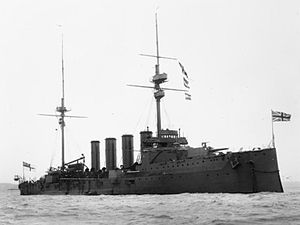m "Screws" is not a full name for the items in dispute - "Screw propeller" is a better discription for non maritime readers of Wikipedia! |
|||
| Line 45: | Line 45: | ||
|Ship ice class= |
|Ship ice class= |
||
|Ship power= |
|Ship power= |
||
|Ship propulsion=19 Yarrow boilers<br>Twin 4-cylinder triple-expansion steam engines<br>two |
|Ship propulsion=19 Yarrow boilers<br>Twin 4-cylinder triple-expansion steam engines<br>two screw propellers<br>23,500 hp (17.5 MW) |
||
|Ship sail plan= |
|Ship sail plan= |
||
|Ship speed=23 knots |
|Ship speed=23 knots |
||
Revision as of 22:41, 5 January 2010
 HMS Duke of Edinburgh
| |
| Class overview | |
|---|---|
| Name | Duke of Edinburgh |
| Preceded by | Devonshire class cruiser |
| Succeeded by | Minotaur class cruiser |
| Completed | Six |
| General characteristics | |
| Type | first class armoured cruiser |
| Length | list error: <br /> list (help) 480 ft (150 m) between perpendiculars 505.3 ft (154.0 m) overall |
| Beam | 73.5 ft (22.4 m) |
| Draught | 27.5 ft (8.4 m) |
| Propulsion | list error: <br /> list (help) 19 Yarrow boilers Twin 4-cylinder triple-expansion steam engines two screw propellers 23,500 hp (17.5 MW) |
| Speed | 23 knots |
| Range | 10,000 nautical miles (19,000 km) at 10 knots (19 km/h) |
| Complement | about 750 |
| Armament |
|
| Armour | list error: <br /> list (help) Belt: 6 in (152 mm) barbette: 7in (178 mm) turret faces: 8 in (203 mm) maximum |
The Duke of Edinburgh-class was a class of six armoured cruisers built around 1905 for the British Royal Navy. The later four ships were armed differently, and are sometimes considered as a separate class, the Warrior-class.
They were the first ships to come from the new Director of Naval Construction, Philip Watts.
The main armament of six 9.2 inch guns was distributed in two centreline turrets (one fore and one aft with wide angles of fire) and four turrets disposed in the corners about the funnels. The secondary was 5 single gun 6-inch barbettes either side. The remainder was some twenty 3-pounder guns concentrated around the masts – 10 fore and 10 aft.
The Warriors replaced the 6 inch barbettes with four 7.5 inch gun turrets on the same deck as the centre main armament.
Service
Natal blew up in December 1915 due to an internal explosion. Warrior, Duke of Edinburgh and Black Prince were at the Battle of Jutland having joined the 1st Cruiser Squadron of the Grand Fleet. Black Prince and Warrior were lost at Jutland. Cochrane and Achilles were in the 2nd Cruiser Squadron. Achilles was undergoing refit and missed Jutland. Cochrane ran aground in the River Mersey in November 1918 and was scrapped. The other survivors of the war were scrapped or sold for scrap by 1921.
Building programme
The following table gives the build details and purchase cost of the members of the Duke of Edinburgh class. Whilst standard British practice at that time was for these costs to exclude armament and stores, the cost quoted in The Naval Annual for this class includes armament.
| Ship | Builder | Engine maker |
Laid down | Launch date | Completed | Cost according to BNA 1914 [1] |
|---|---|---|---|---|---|---|
| Duke of Edinburgh class | ||||||
| Duke of Edinburgh | Pembroke Dockyard | Hawthorn Leslie | 11 Feb 1903 | 14 Jun 1904 | 20 Jan 1906 | £1,201,687 * |
| Black Prince | Thames Ironworks, Blackwall | Thames Ironworks | 3 Jun 1903 | 8 Nov 1904 | 17 Mar 1906 | £1,193,414 * |
| Warrior class | ||||||
| Warrior | Pembroke Dockyard | Wallsend | 5 Nov 1903 | 25 Nov 1905 | 12 Dec 1907 | £1,186,395 * |
| Cochrane | Fairfield, Govan | Fairfield | 24 Mar 1904 | 20 May 1905 | 18 Feb 1907 | £1,193,121 * |
| Achilles | Armstrong, Elswick | Hawthorn | 22 Feb 1904 | 17 Jun 1905 | 22 Apr 1906 | £1,191,103 * |
| Natal | Vickers, Barrow | Vickers | 6 Jan 1904 | 30 Sep 1905 | 5 Mar 1907 | £1,218,244 * |
* = estimated cost, including guns
See also
Notes and references
- ^ Brassey's Naval Annual 1914, p192-199
- Chesnau, Roger and Kolesnik, Eugene (Ed.) Conway's All the World's Fighting Ships, 1860-1905. Conway Maritime Press, 1979. ISBN 0-83170-302-4
- Hythe, Viscount (ed)The Naval Annual 1914